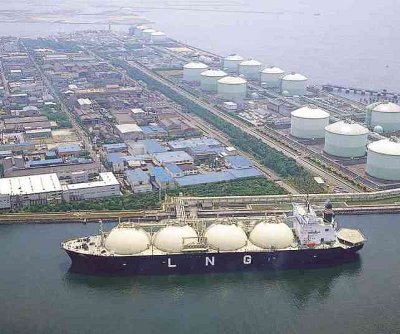E.ON SE’s (OTC: EONGY) E.ON Global Commodities SE (a German company) has reached an agreement with Canada’s Pieridae Energy. E.ON will purchase liquefied natural gas from the Goldboro LNG project located in Nova Scotia, Canada.
The terms of the agreement will allow Pieridae to sell 5 million tons of LNG to the German company annually for 20 years. This is a pretty major deal, and we’ll see why in a moment.
 The Sacramento Bee reports:
The Sacramento Bee reports:
“We are pleased to have reached a long-term agreement with E.ON, which will provide the European gas market and Germany particularly with a new secure source of natural gas supply,” said Alfred Sorensen, President and CEO, Pieridae.
LNG prices, as mentioned in the deal, are based on present market prices for natural gas in Western Europe. Further, Pieridae and Contact Exploration (TSX-V: CEX) are initiating discussions with pipelines and suppliers across North America.
The Goldboro project is huge. When completed, it would be able to export 10 million tons per annum of natural gas, 365 days a year. It will also be able to store 690,000 cubic meters of LNG on-site. Operations are expected to begin by Q1 2020, and natural gas will then be transported via pipeline to Goldboro, from where it will go out internationally via ships.
An environmental assessment is presently underway and is due to the Province of Nova Scotia by the year’s end. Pieridae expects to invest between $5 and $10 billion in the Goldboro project.
Economic Benefits
Nova Scotia and New Brunswick stand to benefit greatly from a successful completion of the Goldboro project. As many as 3,500 jobs are expected to be created during development and at least 200 full-time permanent jobs afterward.
The deal is excellent news for Goldboro, since it can now boast a major customer and a significant deal. That should set in motion a momentum that will see additional customers vying to get in touch. The Globe and Mail reports, for example, that several Indian companies have expressed interest but have held off due to lack of clarity and infrastructure.
Meanwhile in Canada, focus on liquefied natural gas is moving over to the East Coast after a lengthy period of development on the West Coast. It’s also logical, since European nations are demonstrating growing dissatisfaction with Russian giant OAO Gazprom (MM: GAZP).
Rising Gas Exports
It is expected that increasing exports of LNG from Canada will raise North American prices. Further, the Canadian East Coast has numerous natural gas fields both on and offshore, thus inviting further development.
The Goldboro project also represents an advancement for Pieridae, which has struck a joint venture deal with Contact Exploration (mentioned earlier). Contact will be in charge of sourcing, developing, and producing the natural gas that will serve as feedstock for Goldboro.
But gas is also expected to be sourced from the Marcellus Shale in the U.S., as well as from New Brunswick and both on and offshore operations in Nova Scotia.
The Goldboro project’s potential market is very attractive; it includes options across Europe, South America, and most of South Asia. All of those places are much more readily accessible from the Canadian East Coast than the West.
Our analysts have traveled the world over, dedicated to finding the best and most profitable investments in the global energy markets. All you have to do to join our Energy and Capital investment community is sign up for the daily newsletter below.
LNG shipping has become pretty big recently. Much of this is due to exploding demand from Asian nations, where LNG is heavily used. But Europe has also added to the demand as nations seek greater independence from Russian gas supplies. That’s why, given the gas glut across North America, it makes sense for companies to petition for and try to develop gas export terminals and boost their LNG operations.
In the U.S., the Department of Energy just recently approved the Freeport LNG export terminal. Once completed, that’ll raise the nation’s export capability by 1.5 billion cubic feet per day. Of course, the Freeport project will benefit companies like Chevron (NYSE: CVX) and ConocoPhilips (NYSE: COP). More importantly, at least in the short term, it will lead to massive national profits from energy exportation.
The downside is that it cannot be a long-term solution because the more energy that is exported, the more domestic gas prices will rise. At some point, the national competitive advantage will reduce to unsustainable levels.
Fortunately, there is no indication of any slowdowns in the U.S.’s gas production levels, so we needn’t be worried just yet. The Freeport terminal won’t begin exports until almost 2017, but the news caused gas futures for June 2015 to rise 3.8 percent. Clearly, the right people are watching closely.
If you liked this article, you may also enjoy:


